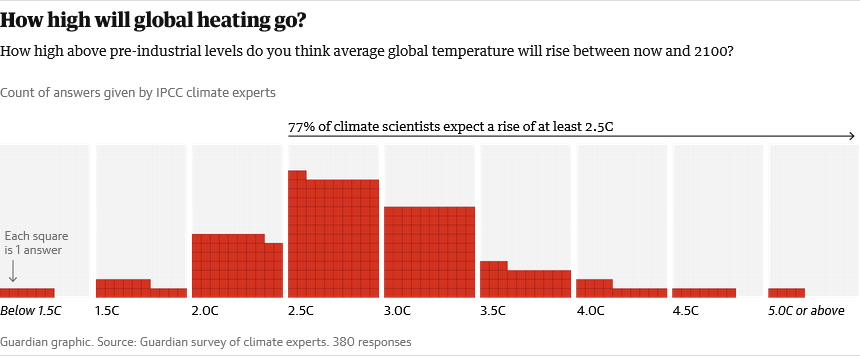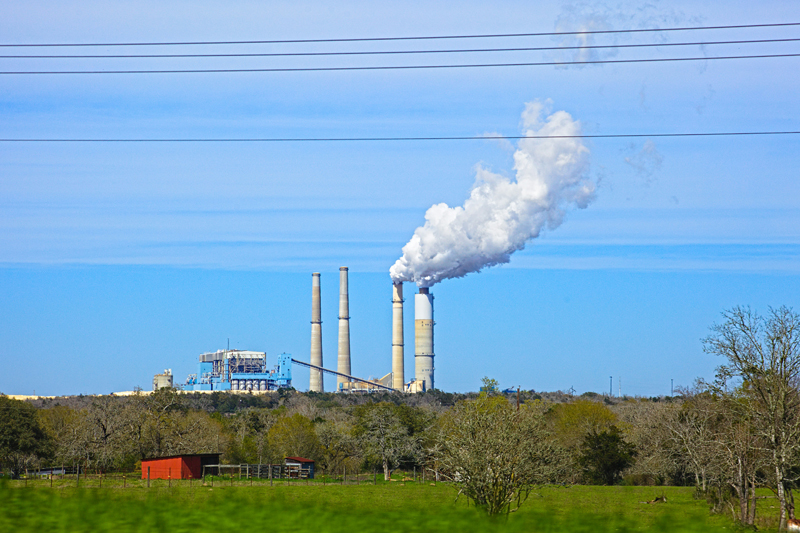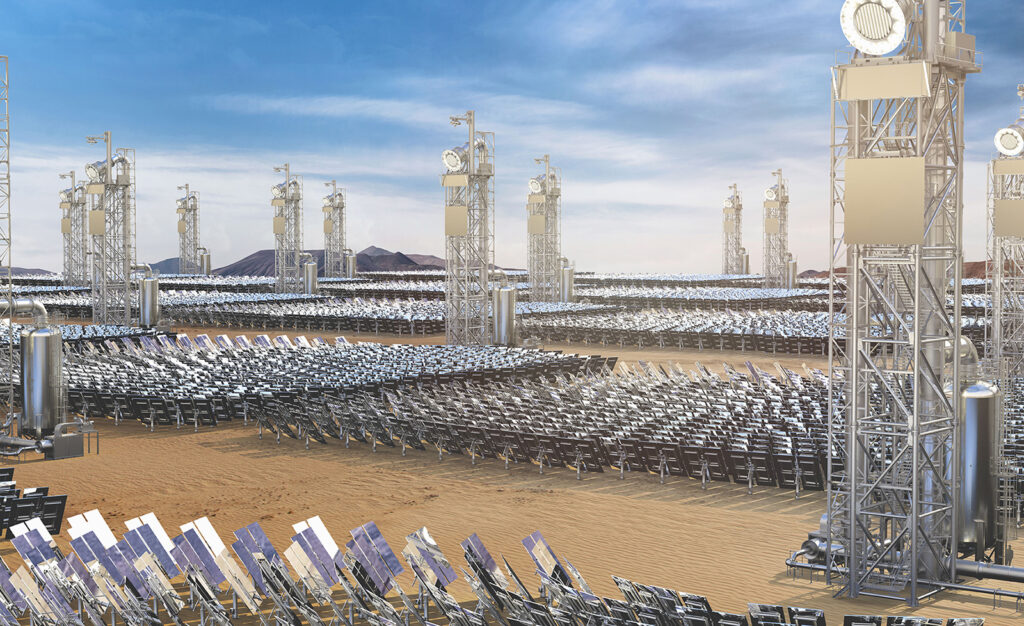TOP CLIMATE SCIENTISTS EXPECT AT LEAST 2.5°C GLOBAL HEATING
If you’re reading this, you likely realize that climate change is an existential issue for our time. Decisions we make, or fail to make, today can have potentially irreversible consequences that will extend beyond our lifetimes. You understand that climate change is happening, that it is accelerating, and that current efforts to abate it are insufficient to the task. Now comes a survey of scientists from The Guardian that shows by how much we’re missing the mark.
The independent newspaper surveyed 380 authors and editors from the Intergovernmental Panel on Climate Change, or IPCC. In the words of The Guardian’s environment editor Damian Carrington, “The IPCC’s reports are the gold standard assessments of climate change.” The results of the survey show that “many of the most knowledgeable people on the planet expect climate havoc to unfold in the coming decades.”
Carrington writes that almost 80% of the survey’s respondents foresee at least 2.5C of global heating by the end of the century, while almost half anticipate at least 3C (5.4F). Only 6% think the internationally agreed target of 1.5C (2.7F) will be met.

A separate article quotes James Hansen, the former NASA scientist credited for alerting the world to the dangers of climate change in the 1980s, saying global heating may pass the 1.5C threshold this year. And the Guardian quotes Jesse Keenan of Tulane University in the US as saying, “The climate crisis is already causing profound damage to lives and livelihoods across the world, with only 1.2C (2.16F) of global heating on average over the past four years.” This is just the beginning, he says, “buckle up.”
Peter Cox, of the University of Exeter in the UK, says in the article, “Climate change will not suddenly become dangerous at 1.5C – it already is. And it will not be ‘game over’ if we pass 2C, which we might well do.”
Lack of will
The 1.5C target was chosen to prevent the worst of the climate crisis and has been seen as an important guiding star for international negotiations. But, says Carrington, “Current climate policies mean the world is on track for about 2.7C. Unfortunately, the Guardian survey shows few IPCC experts expect the world to deliver the huge action required to reduce that.
The experts were clear on why the world is failing to tackle the climate crisis. “A lack of political will was cited by almost three-quarters of the respondents, while 60% also blamed vested corporate interests.”
We realize that most of our readers are engaged with the energy transition and doing what they can in their personal and professional lives to mitigate climate change. So we don’t spend a lot of time recapping statistics that most are already aware of. But the conclusions of the esteemed scientists surveyed by the Guardian were so stark, we thought this a worthwhile reminder of the urgency and enormity of the task we all share.
Read the Guardian article here.
ROUND-THE-CLOCK CLEAN CLEAN ELECTRICITY AND HEAT
400kWe 247Solar Plants deployed at scale
247Solar Plants™ bridge the gap between conventional wind and solar and the need for round-the-clock utility power and industrial-grade heat. 247Solar Plants store the sun’s energy as heat instead of electricity, for 18 hours or more, at much less than the cost of batteries. No generators are required, and 247Solar’s turbines can also burn a variety of fuels, including hydrogen, to ensure 24/7/365 dispatchability.
Extensive Applications
On-grid or off-grid, 247Solar Plants offer a 24/7 alternative to fossil fuels for a broad range of applications:
- CHP: 24/7 low-carbon Combined Heat & Power for industry
- Ultra Heat: Each 247Solar Plant can provide up to 1,500,000 Btu/hr. of heat at temperatures up 1000℃/1800℉ for industrial processes such as cement, glass, steel making, or minerals processing
- Microgrids: Always-on, emissions-free electricity and heat for islands, mines, communities, facilities
- 24/7 baseload power: 24/7 solar electricity, especially for emerging economies
- Green Hydrogen: 24/7 solar electricity and heat to power electrolysis around the clock
- Green Desalination: 24/7 solar electricity and heat to purify water around the clock
U.S. EPA TELLS FOSSIL PLANTS TO CLEAN UP OR CLOSE

Photo by Sam LaRussa on Unsplash
New clean power rules from the U. S. Environmental Protection Agency have set deadlines for the country’s coal and gas plants to decarbonize their activities. Canary Media reports that the new rules, announced April 25th, will require that coal plants slated to stay open past 2039 control 90 percent of their carbon pollution from 2032 onward. Newly built baseload fossil-gas-fired power plants that operate more than 40 percent of the year must do the same.
The rules are intended to help slash emissions from the power sector, which currently accounts for about one-quarter of the country’s carbon footprint.
Canary’s Jeff St. John writes that “Power plant operators affected by the rules have essentially two pathways to stay in business: Retrofit their facilities with technologies that can prevent 90 percent of emissions, like carbon capture, or swap out their fossil-fired assets for clean power installations.”
In announcing the rules, Biden administration officials predicted that carbon-capture (CCS) technology supported by federal incentives could meet the needs of power plants on the timeline the rules set out. But they also stressed the appeal of the other path forward for the power sector —clean energy.
Utilities have long cited CCS as a cornerstone of their low-carbon planning, but the nascent technology has a spotty record. St. John notes that “Billions of dollars of Department of Energy funding directed at power plant CCS projects in the 2010s failed to yield a single successful demonstration.”
On the other hand, ever-cheaper solar, wind, batteries and other carbon-free technologies, combined with hundreds of billions of dollars of federal backing from the Inflation Reduction Act, mean that utilities and plant owners may finally realize that existing clean energy technologies represent the fastest, most economical way to lower their carbon footprints.
Read more.
LATIN AMERICA AT THE CROSSROADS OF THE ENERGY TRANSITION

tifonimages/iStock
Latin America has unique advantages with respect to the energy transition, but the region’s ability to fully contribute to the fight against climate change is constrained.
Cipher’s Amena Saiyid writes that “The region is home to at least one-fifth of the world’s rainforests and has one of the lowest-emitting electricity systems in the world. It has immense potential to generate even more clean energy and develop more technologies, like hydrogen, from its abundant wind and solar resources. The region also holds a third of the world’s copper and lithium reserves, materials key to the energy transition.”
Yet despite these advantages, Latin American countries are finding it hard to develop their industries and market their clean products. This is because they are grappling with other socioeconomic priorities and economic constraints due to high debt levels, elevated interest rates and poor credit ratings.
These countries also face competition from new U.S. clean-energy subsidies and a forthcoming E.U. border tax on carbon-intensive goods, on top of China’s decades-long dominance in cleantech products and raw materials. Together, these factors make it harder for local businesses to borrow money from financial institutions, which is necessary to build out clean energy projects and develop green industries.
As Brazil prepares to host this year’s Group of 20 countries (G20) meeting in July, the region’s countries are asking for a “fair and inclusive” transition that allows them to develop their own green economies, fully leverage their unique resources, and maximize their contribution to global efforts to combat climate change.
Read more.
FOLLOW & JOIN 247Solar
Contact: info@247solar.com
